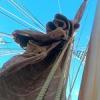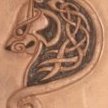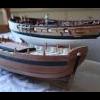Supplies of the Ship Modeler's Handbook are running out. Get your copy NOW before they are gone! Click on photo to order.
×
-
Posts
841 -
Joined
-
Last visited
Reputation Activity
-
 michaelpsutton2 got a reaction from Canute in How do I clean a filthy 2.5m balsawood battleship.
michaelpsutton2 got a reaction from Canute in How do I clean a filthy 2.5m balsawood battleship.
I saw a documentary on PBS about folks who clean old paintings. Believe it or not: Saliva
-
 michaelpsutton2 got a reaction from AJohnson in HMS Convulsion paint scheme
michaelpsutton2 got a reaction from AJohnson in HMS Convulsion paint scheme
My general impression is that the yellow ochre was much commony in 1804 than when the Grenado was launched in 1742. I also believe that the smaller vessels were more likely to be painted in non-standard colors than major fleet units
-
 michaelpsutton2 got a reaction from mtaylor in How do I clean a filthy 2.5m balsawood battleship.
michaelpsutton2 got a reaction from mtaylor in How do I clean a filthy 2.5m balsawood battleship.
I saw a documentary on PBS about folks who clean old paintings. Believe it or not: Saliva
-
 michaelpsutton2 got a reaction from Canute in HMS Convulsion paint scheme
michaelpsutton2 got a reaction from Canute in HMS Convulsion paint scheme
My general impression is that the yellow ochre was much commony in 1804 than when the Grenado was launched in 1742. I also believe that the smaller vessels were more likely to be painted in non-standard colors than major fleet units
-
 michaelpsutton2 got a reaction from AJohnson in HMS bounty colour?
michaelpsutton2 got a reaction from AJohnson in HMS bounty colour?
After the mutiny, Capt Bligh's voyage and the trial of the mutineers the Bounty had become one of the most famous vessels in history. It was big news several times years apart. Had she been painted in any but the most normal colors of the day surely it would have been mentioned. You could picture some old harbor drunk saying"I knew that bright pink ship would come to no good" But all the sources are silent on her appearance, so it must have been plain as can be. I wouldn't get to decorative. If you look at William Dodd's aquatint of Captain Bligh being put into the boat, there is not a drop of blue on her. Dodd was contemporary with the events but I do not think he could ever have claimed to have seen her. He could have met some those who sailed on her though color scheme used on the recent Endevour replica would probably serve. Here is one I think might not be too far off:
http://www.stephensandkenau.com/ship/hms-bounty/
https://en.wikipedia.org/wiki/William_Bligh#/media/File:Mutiny_HMS_Bounty.jpg
-
 michaelpsutton2 got a reaction from GemmaJF in HMS bounty colour?
michaelpsutton2 got a reaction from GemmaJF in HMS bounty colour?
After the mutiny, Capt Bligh's voyage and the trial of the mutineers the Bounty had become one of the most famous vessels in history. It was big news several times years apart. Had she been painted in any but the most normal colors of the day surely it would have been mentioned. You could picture some old harbor drunk saying"I knew that bright pink ship would come to no good" But all the sources are silent on her appearance, so it must have been plain as can be. I wouldn't get to decorative. If you look at William Dodd's aquatint of Captain Bligh being put into the boat, there is not a drop of blue on her. Dodd was contemporary with the events but I do not think he could ever have claimed to have seen her. He could have met some those who sailed on her though color scheme used on the recent Endevour replica would probably serve. Here is one I think might not be too far off:
http://www.stephensandkenau.com/ship/hms-bounty/
https://en.wikipedia.org/wiki/William_Bligh#/media/File:Mutiny_HMS_Bounty.jpg
-
 michaelpsutton2 got a reaction from Canute in HMS bounty colour?
michaelpsutton2 got a reaction from Canute in HMS bounty colour?
After the mutiny, Capt Bligh's voyage and the trial of the mutineers the Bounty had become one of the most famous vessels in history. It was big news several times years apart. Had she been painted in any but the most normal colors of the day surely it would have been mentioned. You could picture some old harbor drunk saying"I knew that bright pink ship would come to no good" But all the sources are silent on her appearance, so it must have been plain as can be. I wouldn't get to decorative. If you look at William Dodd's aquatint of Captain Bligh being put into the boat, there is not a drop of blue on her. Dodd was contemporary with the events but I do not think he could ever have claimed to have seen her. He could have met some those who sailed on her though color scheme used on the recent Endevour replica would probably serve. Here is one I think might not be too far off:
http://www.stephensandkenau.com/ship/hms-bounty/
https://en.wikipedia.org/wiki/William_Bligh#/media/File:Mutiny_HMS_Bounty.jpg
-
 michaelpsutton2 got a reaction from Keithsalter in HMS bounty colour?
michaelpsutton2 got a reaction from Keithsalter in HMS bounty colour?
The Bounty was copper sheathed. The copper is still being found at her gravesite at Pitcairn Island
-
 michaelpsutton2 got a reaction from mtaylor in HMS bounty colour?
michaelpsutton2 got a reaction from mtaylor in HMS bounty colour?
http://archive.archaeology.org/9905/etc/bounty.html
Maybe this will be of some interest
-
 michaelpsutton2 got a reaction from allanyed in HMS bounty colour?
michaelpsutton2 got a reaction from allanyed in HMS bounty colour?
http://archive.archaeology.org/9905/etc/bounty.html
Maybe this will be of some interest
-
 michaelpsutton2 got a reaction from AJohnson in HMS bounty colour?
michaelpsutton2 got a reaction from AJohnson in HMS bounty colour?
The Bounty was copper sheathed. The copper is still being found at her gravesite at Pitcairn Island
-
 michaelpsutton2 got a reaction from Piet in Young America 1853 by EdT - FINISHED - extreme clipper
michaelpsutton2 got a reaction from Piet in Young America 1853 by EdT - FINISHED - extreme clipper
I am just now looking at your mast. I see where McLean points out that some masts were "filled under the hoops". The fact that he takes note of it for some ships means that it was not universal. Which way are you going?
-
 michaelpsutton2 got a reaction from mtaylor in Young America 1853 by EdT - FINISHED - extreme clipper
michaelpsutton2 got a reaction from mtaylor in Young America 1853 by EdT - FINISHED - extreme clipper
I am just now looking at your mast. I see where McLean points out that some masts were "filled under the hoops". The fact that he takes note of it for some ships means that it was not universal. Which way are you going?
-
 michaelpsutton2 got a reaction from Siegfried in HMS bounty colour?
michaelpsutton2 got a reaction from Siegfried in HMS bounty colour?
The Bounty was copper sheathed. The copper is still being found at her gravesite at Pitcairn Island
-
 michaelpsutton2 got a reaction from AJohnson in HMS bounty colour?
michaelpsutton2 got a reaction from AJohnson in HMS bounty colour?
There are no known contemporary pictures of her. The cover of the "Anatomy of the Ship" series book is about as close as anything. But look carefully a lot of what appears black is really dark brown.
I grew up with the image of the bounty from the 1960's movie: Blue Hall with yellow molding. It hard to let go of and accept the duller but more likely alternative
-
 michaelpsutton2 got a reaction from Obormotov in MONTAÑES by Amalio
michaelpsutton2 got a reaction from Obormotov in MONTAÑES by Amalio
The compound curves up to the counter a superbly articulated
-
 michaelpsutton2 got a reaction from wefalck in Question: Help to Identify drumhead of windlass
michaelpsutton2 got a reaction from wefalck in Question: Help to Identify drumhead of windlass
My uneducated guess is that they only went to the windlass when actually hoisting. At other times the windlass needed to be free for other tasks.
-
 michaelpsutton2 got a reaction from JerseyCity Frankie in Question: Help to Identify drumhead of windlass
michaelpsutton2 got a reaction from JerseyCity Frankie in Question: Help to Identify drumhead of windlass
My uneducated guess is that they only went to the windlass when actually hoisting. At other times the windlass needed to be free for other tasks.
-
 michaelpsutton2 got a reaction from mtaylor in Question: Help to Identify drumhead of windlass
michaelpsutton2 got a reaction from mtaylor in Question: Help to Identify drumhead of windlass
My uneducated guess is that they only went to the windlass when actually hoisting. At other times the windlass needed to be free for other tasks.
-
 michaelpsutton2 got a reaction from jablackwell in Question: Help to Identify drumhead of windlass
michaelpsutton2 got a reaction from jablackwell in Question: Help to Identify drumhead of windlass
My uneducated guess is that they only went to the windlass when actually hoisting. At other times the windlass needed to be free for other tasks.
-
 michaelpsutton2 reacted to EdT in Young America 1853 by EdT - FINISHED - extreme clipper
michaelpsutton2 reacted to EdT in Young America 1853 by EdT - FINISHED - extreme clipper
Young America - extreme clipper 1853
Part 170 – Rigging Cleats 1
Most of the work to be done before embarking on masts and rigging is to install a variety of rigging connection points to the decks and hull. There are two sizes of cleats on the model. They are being made by two different methods. I will start first with the smaller 9" long cleats.
There are a few dozen of these, too many and too small for me to consider fabricating them in pieces, so they were sliced off the milled brass section shown in the first photo.
In the next picture a 9" square rod (1/8" actual) has been aligned on the milling plate, clamped, and is having a shallow, concave groove milled in the top.
Next, the piece was inverted and the sides milled to form the rough fina,l stepped, "T" shape.
The piece was then rounded and refined by filing before slicing off the cleats. The slicing is being done as shown below using a thin slotting saw blade and a sacrificial wood fence.
This method allows the small pieces to be cut to a precise thickness – in this case about 3" (.030" actual). The individual cleats were then rounded by filing and polished as shown below.
The brass cleats were then blackened and finally inserted in drilled holes with a small drop of CA to keep them in place – shown below.
The next picture shows the small cleats installed on the poop deck. These will eventually secure some of the lighter mizzen rigging.
The next picture shows cleats on the forecastle. These are duplicated on the port side and will belay the jib sheets.
In the next part, the larger 12" cleats for the lower sails' sheets and tacks will be described.
Ed
-
 michaelpsutton2 got a reaction from mtaylor in Sources for Rigging tables before Steel 1794 wanted
michaelpsutton2 got a reaction from mtaylor in Sources for Rigging tables before Steel 1794 wanted
Absolutely yes the Medway. But the question I am asking is a larger and more general one.
Imagine the meeting or meetings where the new Establishment was agreed on sometime in 1745. Don't you think that sailors captains rigger, so called technical experts would have been called in. Ship's top hamper was constantly being repaired, modified, and experimented with. Look at the never ending discussions on this website about the finer points of Old Ironsides rig. So I think these guy showed up and said "here are some things we have been doing at sea over the last few years that improve performance".And they got them made official. Under that scenario you might reasonably find some of the changes of 1745 actually in use on ship prior to that time.
Everyone is fixated on the ratio of beam to mainmast. True enough and it changes over time. But the other spars changed in relation to the main mast as well. In particular the length of the topgallant yards in relation to the length of the other yard increased steadily over the years. You can see from my tables abovevtheratio of topgallant yard yo topsail yard went from .58 in 1719 to .69 in 1745.The ratio of the topsail yard to the main yard remained at .7 The ratio of the topgallant mast to the top mast remained the same as well at about .48-.49. The topgallants in 1745 were noticblely wider in proportion to thier depths and to the topsails in 1745 than in 1719. This had the effect of reducing the taper of the sail plan as it went up. I ma certainly not an engineer but it must have been improvements in hull stability and spar materials that allowed them to raise the center of effort.
So the question is which Establishment do my self titled" inter-Establishment" ship look most like.
-
 michaelpsutton2 got a reaction from mtaylor in Sources for Rigging tables before Steel 1794 wanted
michaelpsutton2 got a reaction from mtaylor in Sources for Rigging tables before Steel 1794 wanted
I think maybe my question has been misunderstood. Years ago I calculated the ratios for different periods from the tables in Lees (see attached). What I am trying to figure out is when to use the 1745 ratio, possibly adjusted for beam and when to use the 1719 ratios, again adjusted for beam.
Would you use the 1719 ratios, adjusted for beam, on ships of the 1733 & 1741 proposals, or the 1745.
The 1745 ratios produce a sail plan that is quite a bit wider at the top. Squarer if you will.
By the way if anyone wants copies of the ratios, just drop me line.
-
 michaelpsutton2 got a reaction from mtaylor in Sources for Rigging tables before Steel 1794 wanted
michaelpsutton2 got a reaction from mtaylor in Sources for Rigging tables before Steel 1794 wanted
So taking as an example HMS Medway 1742. She had a beam of 41'5", some 6% more than the 1719 Establishment spec of 39'. And a displacement of 1080 tons a full 13% more than the 1719 number. You would take the 1719 spar dimensions and proportionally increase them by something. But you would not use the proportions of 1745.
By the way a bit of rather imprecise Photoshop work to allow for perspective and lens distortion with the pic's I have seems to show that the ratios of the yards to one another on the NMM model is closer to what we see in the 1719 Establishment than to 1745. It is of course almost impossible to get good measurements with pictures taken at random and unknown angles.
-
 michaelpsutton2 got a reaction from mtaylor in Sources for Rigging tables before Steel 1794 wanted
michaelpsutton2 got a reaction from mtaylor in Sources for Rigging tables before Steel 1794 wanted
I do understand that the changes in the dimensions of the ships were on the whole relatively conservative. So do the 1719 spar dimensions hold true up until
Jan 1, 1745? Or had they been "field" tested prior to that date?












